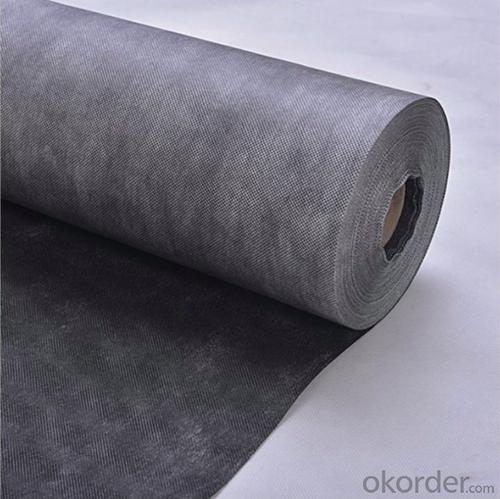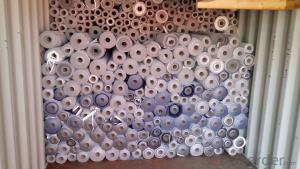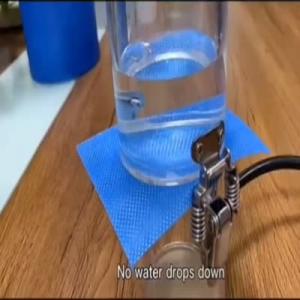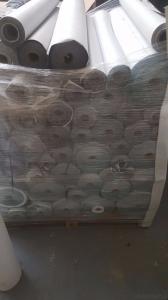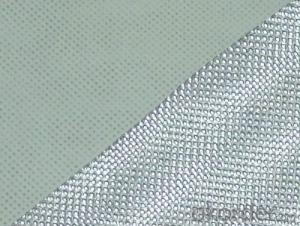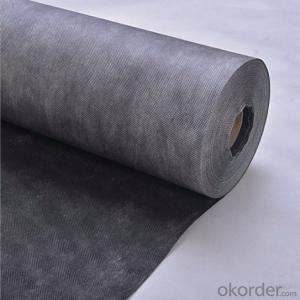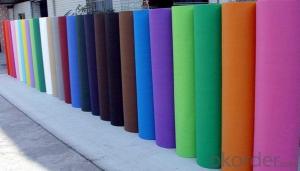Building materials Synthetic roofing felt Breathable Waterproof Membrane
- Loading Port:
- SHANGHAI
- Payment Terms:
- TT OR LC
- Min Order Qty:
- 8500 m²
- Supply Capability:
- 100000 m²/month
OKorder Service Pledge
OKorder Financial Service
You Might Also Like
Product Feature:
Air open & vapour permeable
More breathable than any other 'air open' underlay on the market
Lowest vapour resistance of all breathable membranes
Being both air open & vapour permeable further minimises the risk of condensation forming
No ventilation required
Strong 3 layer material
Superior nail tear strength
| Mass per unit area: | 140g/m2 |
| Product Type: | Waterproofing Breathable Bembrane For House Wrapping |
| Material: | PP/PE granule |
| Tensile Strength(MD/XD): | 190N/5cm(+-20%)/150N/5cm(+-20%) |
| Resistance to tearing(MD/XD): | >50N/50N |
| Flexibility at low temperature: | (-)24°C |
| Resistance to water pentration: | W1 |
| Temperature resistance | (+)70°C |
| Resistance to UV | 3momths |
| Loading quantity | 40' HC ---2000rolls |
Our company :
our company is a leading professional manufacturer in China, which locates in Yangzhou State-grade Development Zone,Yangzhou City, Jiangsu Province, nearby Shanghai.
We have advanced production lines with the technology from Italy and Germany, which are applied to nonwoven products, film lamination, roofing materials, disposable medical products, packaging materials and so on.Main products:Nonwoven fabric , SMS, SMMS and manufactured productsFilm or foil laminated products Roofing membrane, flooring underlayPE woven fabric, PE tarpaulin, vapor barrierGreenhouseWe not only have first-class processing line, but have first-grade quality management. We have been qualified by ISO9001 (quality) and CE, this system can supply active way to guarantee the quality. We have exported to many countries, such as Canada, USA, Chile, Argentina, New Zealand, Australia, Malaysia, Japan, Ukraine, Latvia, Slovenia, Slovakia, Spain, CZ, Russia, Croatia, Bulgaria, Romania, Italy, UK, Germany, Greece and so on. With a group of excellent senior management and hi-tech R& D personnel and our skilled workers, we can supply you the goods with competitive prices and better quality. We look forward to establish friendly and long term relationship with you in the near future.
FAQ:
1. who are we?
We are based in Jiangsu, China, start from 2008,sell to Eastern Europe(18.00%),Southern Europe(15.00%),Northern Europe(15.00%),Western Europe(12.00%),South Asia(6.00%),Eastern Asia(5.00%),Oceania(5.00%),Central America(5.00%),Southeast Asia(5.00%),North America(3.00%),South America(3.00%),Africa(3.00%),Domestic Market(3.00%),Mid East(2.00%). There are total about 11-50 people in our office.
2. how can we guarantee quality?
Always a pre-production sample before mass production;
Always final Inspection before shipment;
3.what can you buy from us?
Breathable Membrane, Reflection Breathable Membrane, Housewrap, Vapor Barrier, Heat Insulation Film
4. why should you buy from us not from other suppliers?
We not only have first-class processing line, but have first-grade quality management. We have been qualified by ISO9001 (quality) and CE, this system can supply active way to guarantee the quality. We have exported to many countries, such as Canada, USA,
5. what services can we provide?
Accepted Delivery Terms: FOB,CFR,CIF,EXW;
Accepted Payment Currency:USD,EUR,JPY,CAD,HKD,CNY;
Accepted Payment Type: T/T,L/C,Credit Card,PayPal,Western Union,Cash;
- Q: Can a waterproofing membrane be used on swimming pools?
- Indeed, swimming pools can utilize a waterproofing membrane. It is a prevalent and efficient technique to guarantee the pool's impermeability. Normally composed of PVC or rubber, waterproofing membranes are specially crafted to obstruct water infiltration through the pool's walls or floor. They are applied as a fine layer or sheet across the pool's surfaces, forming a barrier that confines the water within. This approach diminishes the likelihood of leaks and water-related harm, safeguarding the longevity and functionality of the pool.
- Q: Can a waterproofing membrane be used on tunnels with ventilation systems?
- Yes, a waterproofing membrane can be used on tunnels with ventilation systems. In fact, it is commonly used to prevent water infiltration and protect the structure of the tunnel. The membrane is installed on the exterior walls and ceiling of the tunnel, ensuring that any water that may enter is diverted away from the tunnel and its ventilation system. This helps to maintain the integrity of the tunnel and ensures proper functioning of the ventilation system.
- Q: Are there any specific installation techniques for corners and edges when using a waterproofing membrane?
- Yes, there are specific installation techniques for corners and edges when using a waterproofing membrane. These techniques are important to ensure that the corners and edges are properly sealed and protected from water infiltration. For corners, it is recommended to use corner flashings or preformed corner pieces specifically designed for waterproofing applications. These corner flashings or preformed pieces are typically made of flexible materials such as rubber or PVC and are installed over the membrane to provide a watertight seal. They should be securely fastened to the substrate and overlapped with the membrane to create a continuous barrier against water. When it comes to edges, it is crucial to install edge flashings to prevent water from seeping underneath the membrane. Edge flashings are installed along the perimeter of the waterproofing membrane and are typically made of the same material as the membrane itself. They should be properly sealed and securely fastened to the substrate to ensure a tight and reliable seal. Additionally, it is important to properly overlap the membrane at corners and edges to create a seamless and continuous barrier against water. The manufacturer's instructions should be followed carefully to ensure the correct overlap width and method. Generally, a minimum overlap of at least 2 inches is recommended for corners and edges. Overall, the specific installation techniques for corners and edges when using a waterproofing membrane involve the use of corner and edge flashings, proper sealing and fastening, and correct overlap of the membrane. Following these techniques will help to ensure a reliable and effective waterproofing system.
- Q: Can a waterproofing membrane be used in conjunction with warranty or insurance policies?
- Typically, a waterproofing membrane can be used alongside warranty or insurance policies. Various waterproofing products and systems come with warranties that offer coverage for a specific duration, typically ranging from 5 to 20 years or even longer. These warranties often guarantee the effectiveness and durability of the waterproofing membrane, and may include provisions for repairs or replacements in the event of any failures or defects. Moreover, insurance policies may also provide coverage for damages caused by water leaks or flooding. By installing a waterproofing membrane, property owners can minimize the risk of water damage and potentially lower their insurance premiums. It is advisable to inquire with your insurance provider to determine if they offer any discounts or incentives for utilizing waterproofing systems. Nevertheless, it is crucial to note that the coverage provided by warranties and insurance policies may vary based on specific terms and conditions. It is recommended that you carefully review the details of the warranty or insurance policy and seek guidance from professionals to ensure that the waterproofing membrane aligns with the requirements and specifications outlined in these agreements.
- Q: What is the recommended temperature range for applying a waterproofing membrane?
- The recommended temperature range for applying a waterproofing membrane typically varies depending on the specific product being used. However, in general, it is advisable to apply the membrane within a temperature range of 50°F to 90°F (10°C to 32°C). This temperature range ensures optimal bonding and curing of the membrane, allowing for effective waterproofing. It is important to follow the manufacturer's instructions and guidelines for the specific product being used, as they may provide more specific temperature recommendations based on their formulation and application process. Additionally, it is crucial to consider the ambient temperature and conditions during application, as extreme temperatures or weather conditions can affect the performance and effectiveness of the waterproofing membrane.
- Q: Can a waterproofing membrane be used on concrete block surfaces?
- Yes, a waterproofing membrane can be used on concrete block surfaces. Waterproofing membranes are designed to provide a barrier against moisture and water penetration, and they are commonly used on concrete block surfaces to protect against water damage and leaks. These membranes are typically applied as a liquid or sheet material and adhere to the surface of the concrete blocks, creating a protective layer that prevents water from seeping through. The waterproofing membrane helps to extend the lifespan of the concrete blocks by reducing the risk of water damage, mold growth, and deterioration. It is important to choose a waterproofing membrane that is specifically designed for concrete block surfaces and follow the manufacturer's instructions for proper installation to ensure the best results.
- Q: Are waterproofing membranes suitable for underground parking garages?
- Underground parking garages necessitate waterproofing membranes due to their constant exposure to groundwater and moisture. These factors can result in water infiltration and structural damage. Waterproofing membranes offer an effective solution to prevent water penetration and safeguard the concrete structure from deterioration. The purpose of waterproofing membranes is to establish a barrier against water and moisture, effectively barring their entry into the garage. These membranes are commonly applied to the parking garage's exterior walls, foundation, and floor slab. They are crafted from durable materials like modified bitumen, polyurethane, or rubberized asphalt, capable of withstanding the harsh conditions of underground environments. By incorporating waterproofing membranes into underground parking garages, the likelihood of water damage, such as concrete cracking, reinforcement steel corrosion, and mold growth, is significantly reduced. The membranes serve as a protective layer, guaranteeing the longevity and structural integrity of the parking garage. Moreover, waterproofing membranes can also aid in minimizing vapor transmission, which may trigger condensation and humidity problems within the parking garage. This is especially crucial for underground parking garages located in regions with high water tables or susceptible to heavy rainfall. All in all, waterproofing membranes are an indispensable aspect of constructing or renovating underground parking garages. They offer a dependable and enduring solution to shield the structure from water infiltration, ensuring the safety and durability of the parking facility.
- Q: Can a waterproofing membrane be used in conjunction with vapor barriers?
- Using both a waterproofing membrane and vapor barriers together is highly recommended to provide thorough protection against moisture. Waterproofing membranes effectively block water from penetrating surfaces like roofs or foundations, while vapor barriers prevent the passage of water vapor. By utilizing both, you can prevent both liquid water and water vapor from causing any harm to a structure. The waterproofing membrane acts as a physical barrier, ensuring that water cannot enter, while the vapor barrier stops moisture buildup within the structure. This combination is especially advantageous in regions with high humidity or areas at risk of water intrusion.
- Q: Can a waterproofing membrane be used for food processing facilities?
- Yes, a waterproofing membrane can be used for food processing facilities. These membranes are specifically designed to prevent water penetration and can be installed in areas where food is processed to ensure a hygienic and moisture-resistant environment.
- Q: Whether the polyester waterproofing membrane can be used for roofing waterproofing
- 2, roof waterproofing is not just a layer of waterproof membrane, according to the design of the coating is usually used waterproof layer + polyester membrane waterproof layer;
Send your message to us
Building materials Synthetic roofing felt Breathable Waterproof Membrane
- Loading Port:
- SHANGHAI
- Payment Terms:
- TT OR LC
- Min Order Qty:
- 8500 m²
- Supply Capability:
- 100000 m²/month
OKorder Service Pledge
OKorder Financial Service
Similar products
Hot products
Hot Searches
Related keywords






